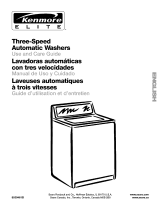Whirlpool 50 Hz User manual
- Category
- Washer dryers
- Type
- User manual
This manual is also suitable for
Whirlpool 50 Hz is a washer/dryer that boasts a variety of features to make laundry day easier. With its 230-volt power supply and 50 Hz frequency, it delivers exceptional performance. It is equipped with an earthing wire for safety, ensuring protection from electrical hazards. Additionally, the Schuko-type power supply cord and plug provide a secure connection and prevent accidental disconnection.
Whirlpool 50 Hz is a washer/dryer that boasts a variety of features to make laundry day easier. With its 230-volt power supply and 50 Hz frequency, it delivers exceptional performance. It is equipped with an earthing wire for safety, ensuring protection from electrical hazards. Additionally, the Schuko-type power supply cord and plug provide a secure connection and prevent accidental disconnection.







-
 1
1
-
 2
2
-
 3
3
-
 4
4
-
 5
5
-
 6
6
-
 7
7
Whirlpool 50 Hz User manual
- Category
- Washer dryers
- Type
- User manual
- This manual is also suitable for
Whirlpool 50 Hz is a washer/dryer that boasts a variety of features to make laundry day easier. With its 230-volt power supply and 50 Hz frequency, it delivers exceptional performance. It is equipped with an earthing wire for safety, ensuring protection from electrical hazards. Additionally, the Schuko-type power supply cord and plug provide a secure connection and prevent accidental disconnection.
Ask a question and I''ll find the answer in the document
Finding information in a document is now easier with AI
Related papers
-
Whirlpool 8316473A User manual
-
Whirlpool 8316566 User manual
-
Whirlpool W10038100 User manual
-
Whirlpool W10038080 User manual
-
Whirlpool 60-Hz Models User manual
-
Whirlpool 3358974 User manual
-
Whirlpool 3358969 User manual
-
Whirlpool 3LG5701XP User manual
-
Whirlpool 3358968 User manual
-
Whirlpool 3RLBR8543 User manual
Other documents
-
Jenn-Air PRO-STYLE PRD3630NP User manual
-
Magic Chef 2DHTW4305TQ0 Installation guide
-
Maytag 3395325 Installation guide
-
Kenmore 11098764791 Owner's manual
-
Maytag 3395316 Installation Instructions Manual
-
 Kenmore Elite 11023034102 Owner's manual
Kenmore Elite 11023034102 Owner's manual
-
Speed Queen ATEE9ASP176TW01 Installation guide
-
Maytag 3397600 Installation Instructions Manual
-
Kenmore Elite 79671417910 Owner's manual
-
Inglis IM45001 Installation guide







